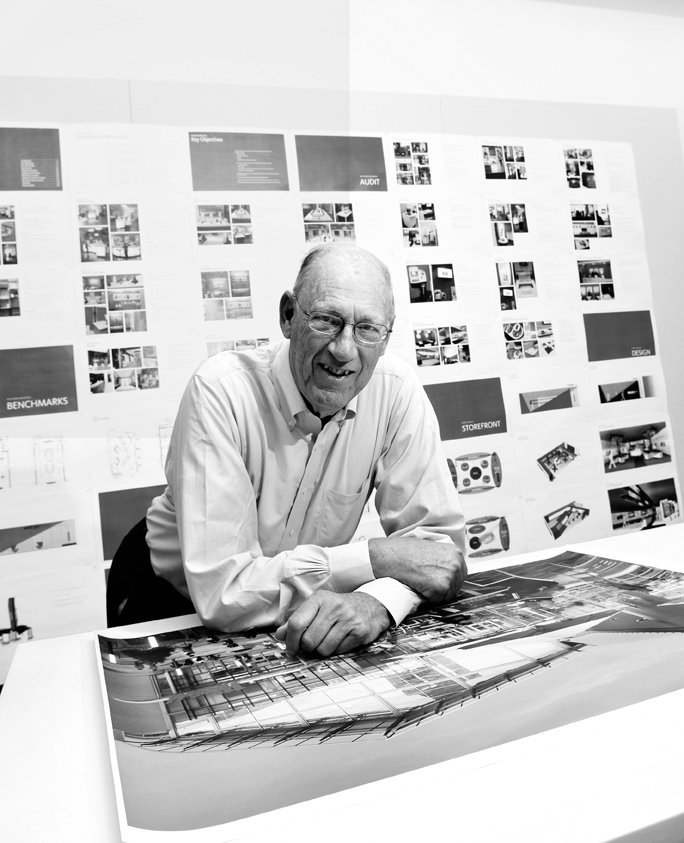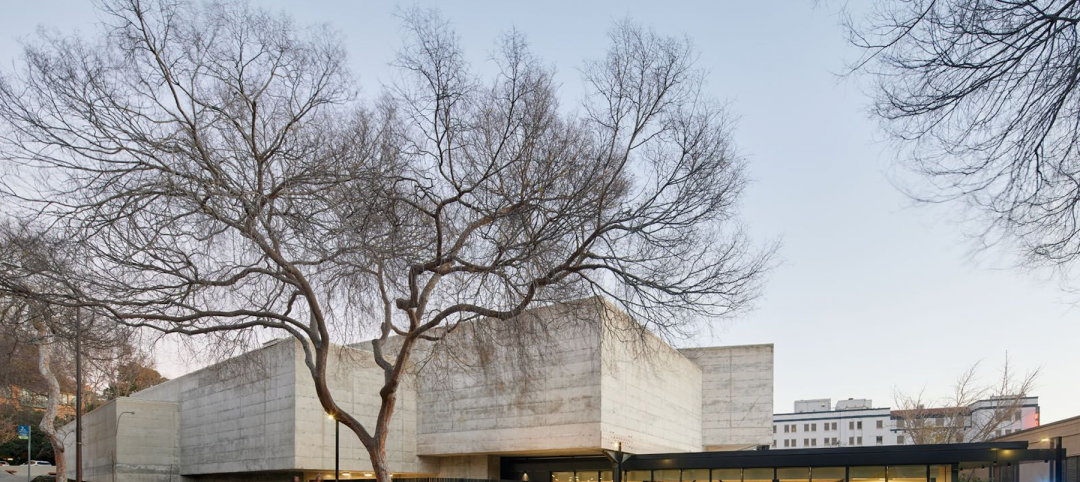After running what is today the largest architecture firm in the world for more than four decades, M. Arthur Gensler, Jr., FAIA, FIIDA, RIBA, is content to be just another employee at the firm that bears his name. “I sold my stock back to the firm, and now I consult with the leadership,” says the 76-year-old founder. “Sometimes they agree, sometimes they don’t. It’s advice, not instruction.”
Click here to read Gensler: 'The One Firm Firm", as well as the Gensler profile published in the November 2011 as part of BD+C's Best AEC Firms to Work For.
In fact, Gensler is at the San Francisco office every workday, when he’s not in China leading the firm’s Shanghai Tower project, or consulting with longtime client Sheldon Adelson, CEO of the Las Vegas Sands, or visiting a Gensler office somewhere in the world.
Gensler was born in Brooklyn, N.Y., in 1935. An only child, he grew up in West Hartford, Conn., and graduated from high school in Garden City, Long Island. His mother worked for the phone company. His father, known as “Slats”—no one called him by his first name, Millard, or Arthur, for that matter—sold ceiling tiles for Armstrong Cork Co. “He was one of the best architectural sales reps ever,” Gensler says of his father. “He was all about service to the client.” Years down the road that life lesson would shape the young man’s own business philosophy.
“I wanted to be an architect for as long as I can remember,” he recalls. At Cornell (“I was lucky to be accepted”), where he was an all-Ivy honorable mention soccer star, he met Drue Cortell, a Middlebury College student, at a New Year’s party in 1954. They married in 1957, and Gensler got his BArch the next year. Upon graduating, he fulfilled his ROTC obligation as a six-month wonder in the Army Corps of Engineers.
Then followed several years of job-hopping—in New York, with Shreve, Lamb and Harmon (architects of the Empire State Building), and in Kingston, Jamaica, with Norman and Dawbarn. After two years in Jamaica, his friend, Peter Flack (of engineers Flack & Kurtz), recommended him for a job running the New York office of architect Albert Sigal, who was designing schools that also served as fallout shelters. When the school funding dried up, Gensler decided to relocate to San Francisco with Sigal. In 1962, with three sons in tow (a fourth would come along later), he and Drue headed west, settling in the bayside town of Tiburon, in Marin County.
The new job turned out to be short-lived, so Gensler moved over to Wurster, Bernardi & Emmons, where he directed the development of design standards for the Bay Area Rapid Transit system. “Then, through a friend from Cornell, I had a chance to start my own firm,” he recalled. The opportunity: tenant development for the Alcoa Building, an SOM-designed office tower at 1 Maritime Plaza. In 1965, with Drue as office manager-accountant and Jim Follett as first employee, M. Arthur Gensler Jr. & Associates Inc. was launched.
Gensler laughs when he recalls his business plan: “Feed my family!” He had to stay on part-time at his old firm to make ends meet. Then fortune struck: Cushman and Wakefield hired him to do the tenant work in the Bank of America Building. That was followed by a chance meeting with Donald Fisher, a retail entrepreneur who had just opened a blue jeans store in San Francisco and was looking for a draftsman to help him design another. “Eventually, he hired us to design that second store,” says Gensler. The firm went on to design more than 3,000 stores and most of the offices for the Gap, Old Navy, and Banana Republic.
As more business rolled in and the firm started adding people, Gensler turned to a professor of business at the University of San Francisco for help. “He came in twice a week to teach us how to run a business—he even gave us homework,” says Gensler. As the firm kept hitting new milestones, Gensler called on other consultants (notably McKinsey) for advice in how to run the business.
Although the firm has grown to 41 offices worldwide, certain business practices have not changed. First, there’s the Monday morning telecon, which these days starts in China and circles back an hour-and-a-half later to the Seattle office. “It lets everyone know what’s going on and keeps us consistent in our client relations,” says Gensler.
Another is cash flow. “We’ve counted the cash every Friday afternoon for more than 35 years, so we know how much we have in the bank,” he says. “All of our offices are profitable, and we’re pretty much recession-proof.” That attention to financial detail is one reason the firm has a reputation for being the best-run design firm in the country.
The third practice goes to the client service approach that a young Art Gensler learned from his salesman father. The firm has established master agreements with hundreds of companies, working in 90 countries this year. “We service whatever they need, from the pedantic to the fabulous,” he says. “Our job is to focus on their needs, to be a trusted advisor and part of their team. That’s something all of us believe in. Three or four offices may work on a project, but the firm gets the credit and all the money goes in one pot.”
Outside the office, Gensler is actively involved as a board member of the California College of Arts and as a trustee of both the San Francisco Museum of Modern Art and the Buck Institute for Age Research. He’s on the Advisory Council to Cornell’s College of Architecture, Art, and Planning. He and Drue have 10 grandchildren, from a newborn to two graduate students. Two of their sons are in the firm: David, one of the three Executive Leaders, and Douglas, who directs the Boston office. (Robert is a PGA golf professional in San Diego; Kenneth is an airline pilot.)
Gensler believes that architecture is a still a great profession for young people, despite the recent layoffs (even at his own firm). “Smart young people have a great future, but you have to think of design as ‘Big D,’ not ‘little d,” he says. “You can’t think only of the aesthetics and not also the functional operations of the project, and you have to be flexible enough to meet the short-term changes that happen every day.
“That’s why I get up and go to the office every day, because I hope I can make a difference for our clients.” BD+C
--
Click here to read Gensler: 'The One Firm Firm", as well as the Gensler profile published in the November 2011 as part of BD+C's Best AEC Firms to Work For.
Related Stories
Coronavirus | May 20, 2022
Center for Green Schools says U.S. schools need more support to fight COVID-19
The Center for Green Schools at the U.S. Green Building Council released a new report detailing how school districts around the country have managed air quality within their buildings during the second year of the COVID-19 pandemic.
Regulations | May 20, 2022
Biden’s Clean Air in Buildings Challenge aims to reduce COVID-19 spread
The Biden Administration recently launched the Clean Air in Buildings Challenge that calls on all building owners and operators, schools, colleges and universities, and organizations to adopt strategies to improve indoor air quality in their buildings and reduce the spread of COVID-19.
Building Team | May 20, 2022
Caltech breaks ground on a new center to study climate and sustainability
The California Institute of Technology (Caltech) recently broke ground on its Resnick Sustainability Resource Center.
Laboratories | May 20, 2022
Brutalist former Berkeley Art Museum transformed into modern life science lab
After extensive renovation and an addition, the former Berkeley Art Museum and Pacific Film Archive at the University of California, Berkeley campus reopened in May 2022 as a modern life science lab building.
Sports and Recreational Facilities | May 19, 2022
Northern Arizona University opens a new training center for its student athletes
In Flagstaff, Ariz. Northern Arizona University (NAU) has opened its new Student-Athlete High Performance Center.
Energy-Efficient Design | May 19, 2022
Shipping containers used to build Research Triangle Park’s first community gathering space
Shipping containers were the prominent building material used to construct Boxyard RTP, the first public community and gathering place in North Carolina’s Research Triangle Park (RTP).
Mixed-Use | May 19, 2022
Seattle-area project will turn mall into residential neighborhood
A recently unveiled plan will transform a 463,000 sf mall into a mixed-use destination site in the Seattle suburb of Bellevue, Wash.
Codes and Standards | May 19, 2022
JLL launches non-profit aiming to mitigate climate change
Real estate and investment management firm JLL recently launched JLL Foundation, a non-profit dedicated to making a long-term impact on environmental sustainability.
Office Buildings | May 19, 2022
JLL releases its 2022 Office Fit Out Guide
JLL’s 2022 Office Fit Out Guide report provides benchmark costs to build out a range of office types across major markets in the United States and Canada.
Biophilic Design | May 18, 2022
Horticulturalists conduct research study to understand the value of biophilic design
Benholm Group, horticulturalists that have pioneered the use of plants for interiors over the past 27 years, are collaborating on a research study to understand the value of biophilic design, according to a news release.

















